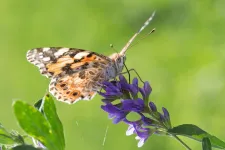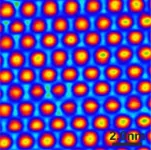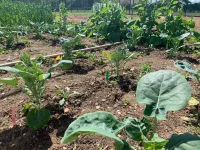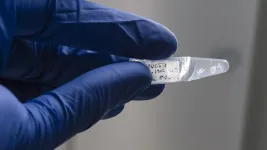INFORMATION:
Butterflies cross the Sahara in longest-known insect migration
Weather conditions shown to have big influence on migration numbers
2021-06-21
(Press-News.org) A species of butterfly found in Sub-Saharan Africa is able to migrate thousands of miles to Europe, crossing the Saharan Desert, in years when weather conditions are favourable, scientists have found.
The striking Painted Lady (Vanessa cardui) butterfly has been shown for the first time to be capable of making the 12,000-14,000km round trip - the longest insect migration known so far - in greater numbers, when wetter conditions in the desert help the plants on which it lays eggs.
The international research team's findings increase understanding of how insects, including pollinators, pests and the diseases they carry could spread between continents in future as climate change alters seasonal conditions.
Professor Tom Oliver, an ecologist at the University of Reading and co-author of the study, said: "We know that the number of Painted Lady butterflies in Europe varies wildly, sometimes with 100 times more from one year to the next. However, the conditions that caused this were unknown, and the suggestion the butterflies could cross the Sahara desert and oceans to reach Europe was not proven.
"This research shows this unlikely journey is possible, and that certain climate conditions leading up to migration season have a big influence on the numbers that make it. It demonstrates how the wildlife we see in the UK can transcend national boundaries, and protecting such species requires strong international cooperation".
As well as answering long-asked questions about butterfly migrations, the findings could help predictions of the movements of other insects that affect people, such as the locusts currently plaguing East Africa, or by malaria-carrying mosquitoes.
Professor Oliver said: "We enjoy seeing the beautiful Painted Lady butterflies in our gardens in Europe, but climate change will also lead to shifts in invasive species that are crop pests or those that spread diseases. Food shortages in East Africa are a reminder that the impacts of climate change can be much more dramatic than a few degrees of warming might first seem."
The Painted Lady migrates during the spring, following a winter breeding season. Researchers used long-term monitoring data from thousands of trained volunteer recorders, along with climate and atmospheric data in regions of Sub-Saharan Africa and Europe to learn about their movement.
The study, published in the Proceedings of the National Academy of Sciences journal, found that increased vegetation in the African Savanna during the winter and in North Africa in the spring, combined with favourable tail winds, are the three most important factors in the number that migrate to Europe.
Painted Lady caterpillars feed on the leaves of plants that thrive in wetter winter conditions in the Savannah and Sahel regions of sub-Saharan Africa, causing population numbers to explode. They migrate across the Sahara, and when there are also wet and green spring conditions in North Africa these allow further breeding and swell the numbers that cross the Mediterranean Sea to reach Europe.
Simulations by the scientists also showed that there are regularly favourable tailwinds between Africa and Western Europe, offering insects opportunities for transcontinental travel.
The team calculated that the butterflies must fly non-stop during the day and rest during night to cross the Sahara, making stops to feed on nectar. This is similar to the pattern in which night-flying songbirds migrate.
They concluded the butterflies must fly up to 1-3km above sea level to take advantage of favourable tailwinds, as their maximum self-powered flying speed of around 6 metres per second would make a Sahara crossing extremely difficult.
The researchers used observations of similar butterfly species to calculate that Painted Ladies have enough body fat after metamorphosis to sustain 40 hours of non-stop flying, and keep this topped up by feeding on nectar whenever possible in order to cross the Sahara.
The findings may help improve predictions of which insect species might be found in different regions in future due to climate change, and the numbers they could arrive in.
ELSE PRESS RELEASES FROM THIS DATE:
Lead from leaded petrol persists in London air despite '90s ban
2021-06-21
Lead levels in London's atmosphere have dropped drastically since lead additives in petrol were phased out, and currently meet UK air quality targets. However despite this drop, airborne particles in London are still highly lead-enriched compared to natural background levels, according to new Imperial research published today in PNAS.
The study found that up to 40 per cent of lead in airborne particles today comes from the legacy of leaded petrol. The researchers say this highlights the long-term persistence of contaminants introduced by human activities in the environment.
Lead author of the study Dr Eléonore Resongles, who carried out the work at Imperial's Department of Earth Science and Engineering, said: "Petrol-derived lead deposited decades ago remains an important ...
New method for molecular functionalization of surfaces
2021-06-21
One vision that is currently driving material scientists is to combine organic molecules (and their diverse functionalities) with the technological possibilities offered by extremely sophisticated semiconductor electronics. Thanks to modern methods of micro- and nanotechnology, the latter designs ever more efficient electronic components for a wide variety of applications. However, it is also increasingly reaching its physical limits: Ever smaller structures for functionalizing semiconductor materials such as silicon cannot be produced using the approaches of classical technology. Scientists ...
Modeling a circular economy for electronic waste
2021-06-21
Think about how many different pieces of technology the average household has purchased in the last decade. Phones, TVs, computers, tablets, and game consoles don't last forever, and repairing them is difficult and often as expensive as simply buying a replacement.
Electronics are integral to modern society, but electronic waste (e-waste) presents a complex and growing challenge in the path toward a circular economy--a more sustainable economic system that focuses on recycling materials and minimizing waste. Adding to the global waste challenge is the prevalence of dishonest recycling practices by companies who claim to be recycling electronics but actually dispose of them by other means, such as in ...
Ben-Gurion U. scientists invent an artificial nose for continuous bacterial monitoring
2021-06-21
BEER-SHEVA, Israel, June 21, 2021 - A team of scientists at Ben-Gurion University of the Negev (BGU) have invented an artificial nose that is capable of continuous bacterial monitoring, which has never been previously achieved and could be useful in multiple medical, environmental and food applications.
The study was published in Nano-Micro Letters.
"We invented an artificial nose based on unique carbon nanoparticles ("carbon dots") capable of sensing gas molecules and detecting bacteria through the volatile metabolites the emit into the air," says lead researcher Prof. Raz Jelinek, BGU vice president ...
Study: Electronic monitoring failed to reduce recidivism for girls in juvenile justice system
2021-06-21
In recent years, many juvenile courts have adopted in-home detention with electronic monitoring tethers as an alternative to institutional incarceration. A new study examined whether this approach reduces recidivism among girls involved in the juvenile justice system. The study found that tethers failed to reduce reoffending among the girls; in fact, they may be harmful because in-home detention limits girls' access to treatment programs.
The study, by researchers at the University of Cincinnati (UC) and Michigan State University, appears in Justice Evaluation Journal, a publication of the Academy of Criminal Justice Sciences.
"We believe this ...
Study examines how breast implant surfaces affect immune response
2021-06-21
HOUSTON - (June 21, 2021) - Rice University bioengineers collaborated on a six-year study that systematically analyzed how the surface architecture of breast implants influences the development of adverse effects, including an unusual type of lymphoma.
Every year, about 400,000 people receive silicone breast implants in the United States. According to FDA data, most of those implants need to be replaced within 10 years due to the buildup of scar tissue and other complications.
A team including researchers from the Massachusetts Institute of Technology (MIT), Rice, the University of Texas MD Anderson Cancer Center and Baylor College of Medicine published its findings online ...
Landmark field trials show potential of gene-editing
2021-06-21
Field trials investigating healthy compounds in agronomically important brassica crops have underlined the "immense potential" of gene editing technology, say researchers.
The trials are the first field application of the technology in the UK since the reclassification of gene-edited crops as genetically modified organisms by the Court of Justice of the European Union (CJEU) in 2018.
The results come as the UK Government is determining whether to allow gene-editing approaches for the purpose of food production, following a DEFRA-led public consultation.
"Our results demonstrate the immense potential for gene-editing to facilitate crop improvement by translating discoveries in fundamental biological processes," ...
AGS publishes updated AGS Minimum Geriatrics Competencies for Graduating Medical Students
2021-06-21
New York (June 21, 2021)--The American Geriatrics Society (AGS) has published an updated version of the AGS Minimum Geriatrics Competencies for Graduating Medical Students, which were created to ensure that medical school graduates across the U.S. are prepared to provide high-quality care for us all as we age. A refresh of the original set first published more than a decade ago, the 27 competencies integrate new concepts that have emerged more recently in the field of geriatrics, including frailty and person-centered care, and are framed around five key areas of focus for all geriatrics healthcare professionals.
"The updated competencies reflect an evolution in how we frame the work of geriatrics health professionals, a greater understanding of frailty, and a greater focus ...
How do developing spinal cords choose 'heads' or 'tails'?
2021-06-21
SAN FRANCISCO, CA--June 21, 2021--The progression from a round ball of cells to an embryo with a head and a tail is one of the most critical steps in an organism's development. But just how cells first start organizing themselves with directionality along this head-to-tail axis is hard to study because it happens in the earliest days of embryonic development, in the confines of a mammal's uterus.
Now, scientists at Gladstone Institutes have created an organoid--a three-dimensional cluster of cells grown in the lab--that mimics the earliest developmental steps of the nervous system in embryos. The organoid is the first to show how human spinal cord cells ...
Poaching affects behavior of endangered capuchin monkeys in Brazilian biological reserve
2021-06-21
A study conducted in the Una Biological Reserve in the state of Bahia, Brazil, shows that in a habitat with high hunting pressure the risk of predation has such a significant impact on the behavior of the Yellow-breasted capuchin monkey Sapajus xanthosternos that it even avoids areas offering an abundant supply of plant biomass and invertebrates, its main sources of food.
An article reporting the findings of the study is published in the American Journal of Primatology.
"Many theories in the field of primatology assume that pressure to find food is more important that predation pressure. In this study we were able ...
LAST 30 PRESS RELEASES:
Decoupling the HOR enhancement on PtRu: Dynamically matching interfacial water to reaction coordinates
Sulfur isn’t poisonous when it synergistically acts with phosphine in olefins hydroformylation
URI researchers uncover molecular mechanisms behind speciation in corals
Chitin based carbon aerogel offers a cleaner way to store thermal energy
Tracing hidden sources of nitrate pollution in rapidly changing rural urban landscapes
Viruses on plastic pollution may quietly accelerate the spread of antibiotic resistance
Three UH Rainbow Babies & Children’s faculty elected to prestigious American Pediatric Society
Tunnel resilience models unveiled to aid post-earthquake recovery
Satellite communication systems: the future of 5G/6G connectivity
Space computing power networks: a new frontier for satellite technologies
Experiments advance potential of protein that makes hydrogen sulfide as a therapeutic target for Alzheimer’s disease
Examining private equity’s role in fertility care
Current Molecular Pharmacology achieves a landmark: real-time CiteScore advances to 7.2
Skeletal muscle epigenetic clocks developed using postmortem tissue from an Asian population
Estimating unemployment rates with social media data
Climate policies can backfire by eroding “green” values, study finds
Too much screen time too soon? A*STAR study links infant screen exposure to brain changes and teen anxiety
Global psychiatry mourns Professor Dan Stein, visionary who transformed mental health science across Africa and beyond
KIST develops eco-friendly palladium recovery technology to safeguard resource security
Statins significantly reduce mortality risk for adults with diabetes, regardless of cardiovascular risk
Brain immune cells may drive more damage in females than males with Alzheimer’s
Evidence-based recommendations empower clinicians to manage epilepsy in pregnancy
Fungus turns bark beetles’ defenses against them
There are new antivirals being tested for herpesviruses. Scientists now know how they work
CDI scientist, colleagues author review of global burden of fungus Candida auris
How does stroke influence speech comprehension?
B cells transiently unlock their plasticity, risking lymphoma development
Advanced AI dodel predicts spoken language outcomes in deaf children after cochlear implants
Multimodal imaging-based cerebral blood flow prediction model development in simulated microgravity
Accelerated streaming subgraph matching framework is faster, more robust, and scalable
[Press-News.org] Butterflies cross the Sahara in longest-known insect migrationWeather conditions shown to have big influence on migration numbers





